Miniature pigs, also known as “teacup pigs” and “micro pigs,” encompass a variety of small pig breeds which are selectively bred to be smaller in size than the average farm pig.
Most farm pigs weigh 600 pounds or more, but any pig weighing less than 350 pounds is considered miniature.
There are a couple of things to consider before deciding to acquire a miniature pig breed, especially if you raise it in your home as a pet.
First, check your local laws before acquiring a miniature pig, as owning a farm animal is illegal in certain residential areas.
Next, be prepared to budget for housing and food costs, as your pig will need adequate indoor and outdoor space and will eat several pounds of food per day.
It is also important to budget for regular vet visits, as miniature pigs have a life expectancy of up to 15 years with proper care.
While owning a pet pig is similar to having a dog in many ways, a pig may require more patience for things like potty training, and their dietary and housing needs are much different.
Once you are prepared for miniature pig ownership, it is time to choose a small pig breed.
Keep reading for our list of 10 small pig breeds to help you decide which one is right for you.
Table of Contents
ToggleAmerican Mini Pig
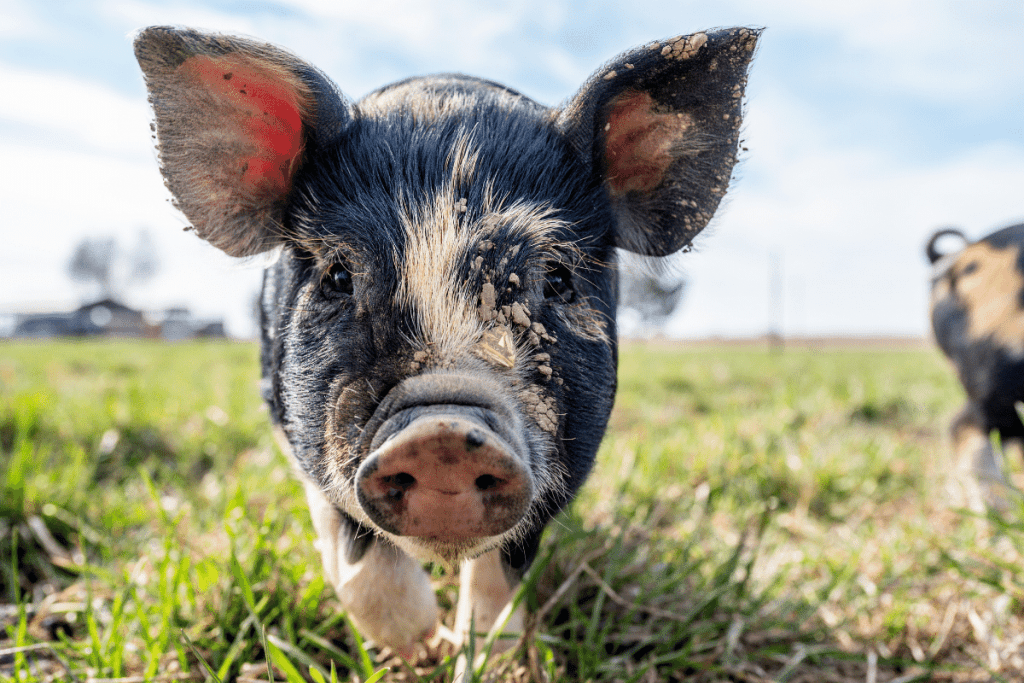
The American Mini Pig breed was developed by combining a variety of small pig breeds worldwide.
American Mini Pigs are specifically bred to be raised as pets, and they are friendly intelligent animals.
An American Mini Pig makes an excellent pet because it is easily trained and smaller than most small pig breeds.
American Mini Pigs reach an average height of 16-20″ inches at the shoulder, and they weigh between 70-150 pounds when fully mature.
Since American Mini Pigs were developed from several pig breeds, their coloration may be solid, spotted, or striped.
They have small erect ears, coarse hair, and a varying snout length.
Mulefoot Hog
The Mulefoot hog is a European pig breed originating from Spain, and it is known for its non-cloven hooves, which are similar to mule hooves.
The American Livestock Breeds Conservancy lists the Mulefoot as critically endangered, and it is one of the rarest American pig breeds.
Mulefoot pigs are one of the largest small pig breeds and are generally raised for their lean meat, but they are also good companion animals.
They have a very docile temperament and tend to be very active, so it is important to provide them with a large outdoor environment.
While not as small as true miniature pigs, the Mulefoot is recognized in the American Mini Pig Association.
Mulefoot pigs are medium-sized, with an average weight between 400-600 pounds.
Male Mulefoot pigs are slightly larger than the females, weighing an average of 550 pounds versus the female’s average weight of 450 pounds.
Mulefoot hogs are usually solid black, but very rarely, they may also have white markings.
They have a thick coat of fine hair and forward-facing ears.
Ossabaw Island Hog
The Ossabaw Island hog is derived from feral pigs on Ossabaw Island, Georgia.
They are thought to have descended from pigs brought to the southern coast from Spanish explorers.
Ossabaw Island pigs are bred on many farms away from the island, but they are still critically endangered.
The Ossabaw Island pig is a very intelligent and friendly animal with a docile temperament.
Ossabaw Island pigs are shorter than 20″ inches at the shoulder and weigh less than 200 pounds.
The Ossavaw Island hog is small due to insular dwarfism, in which the animal evolved to have a reduced body size due to the limited area of the island.
Ossabaw Island pigs may be black, gray, tan, red, or white.
They have thick coats, upright ears, and long snouts.
American Guinea Hog
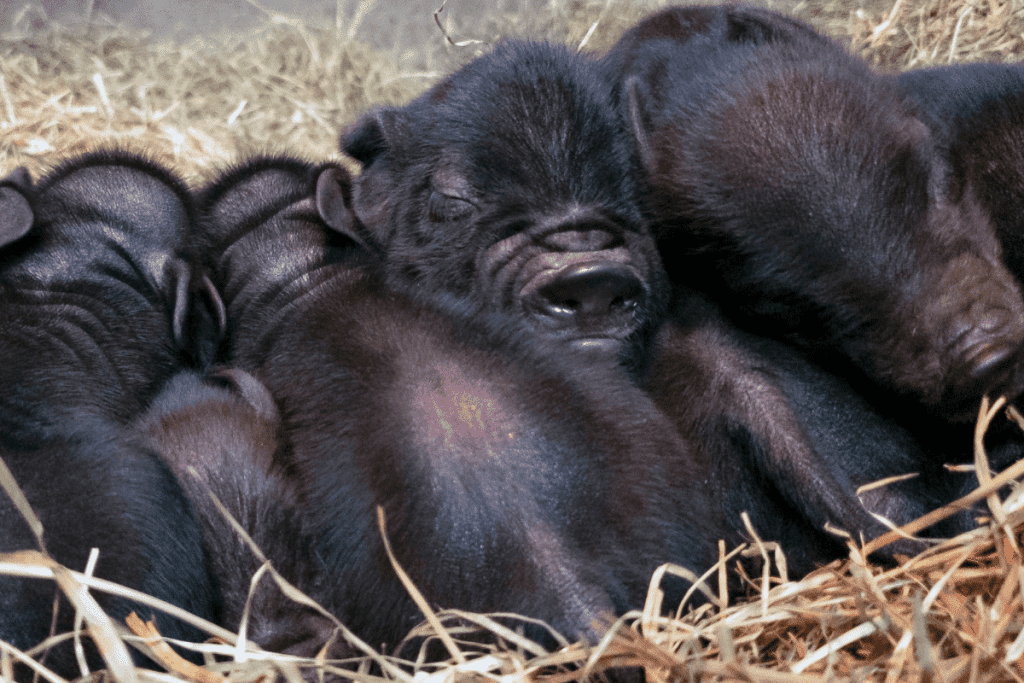
The American Guinea Hog is an American heritage breed of small farm pigs, and it was very common throughout farms in the Southeast around 200 years ago.
The ancestors of this breed are believed to have come from West Africa, and they were popular because they kept rats and snakes away from the homestead and foraged for their food.
However, by the 1990s, fewer than 100 American Guinea Hogs were documented in the United States, and they are considered one of the rarest heritage pig breeds.
American Guinea Hogs are hardy animals, and they can do well in both cold and hot climates.
They are also very intelligent pigs, are easily trained, and have a friendly and docile temperament.
American Guinea Hogs get along well with other animals, making excellent pets.
The adult size of an American Guinea Hog is between 22 to 27″ inches tall and weighs 150 to 200 pounds.
Since these pigs gain weight very quickly, you must not overfeed them.
Most American Guinea Hogs are solid black, but they may also be red or have white markings near their feet or snouts.
They have medium-sized upright ears, a curly tail, and coarse hair on their bodies.
Related: Why do pigs have curly tails?
Kunekune
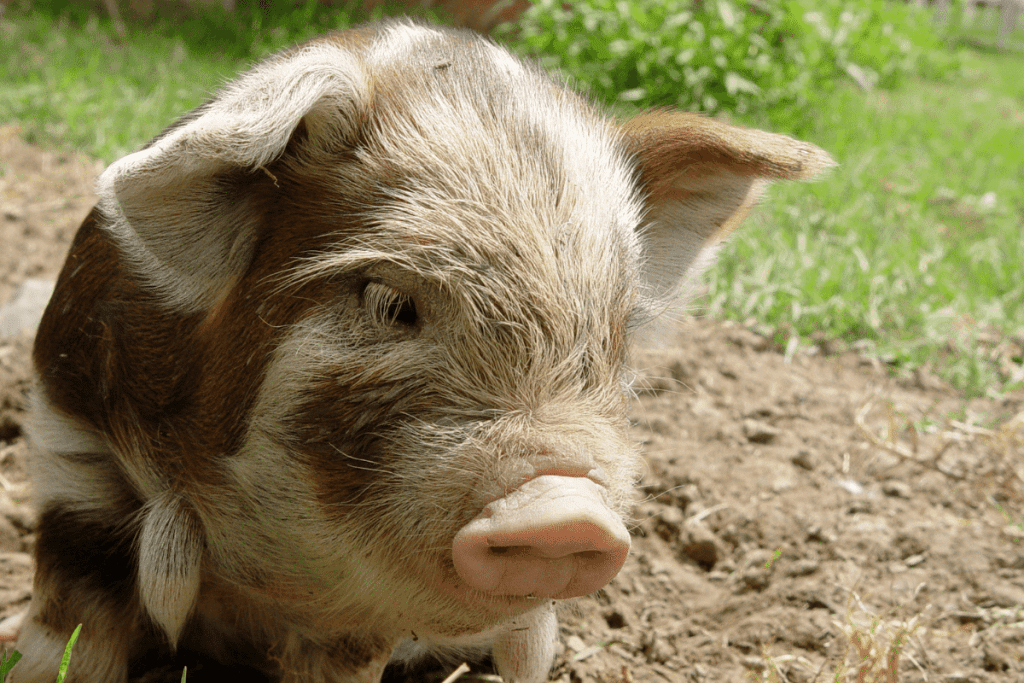
The Kunekune pig breed originates in New Zealand, and its name means “fat and round” in the Maori language.
Kunekune pigs are mainly raised as companion animals, and they are highly intelligent, friendly, and docile.
They get along very well with small children and other pets, and they are also very playful animals.
The Kunekune pig is around 24″ inches tall and weighs between 100-250 pounds when fully grown.
Females are smaller, with an average weight range of 100-175 pounds, while males weigh 200-250 pounds or more.
Kunekune pigs have rounded bodies with long hair and come in many colors, including solid black, black and white, ginger, cream, brown, or tri-colored.
They have forward-facing ears, which may be either semi-lopped or pricked, as well as short, upturned snouts.
Unlike most other pig breeds, the Kunekune will have two wattles under its jowls, and they are often referred to as “tassels.”
Meishan
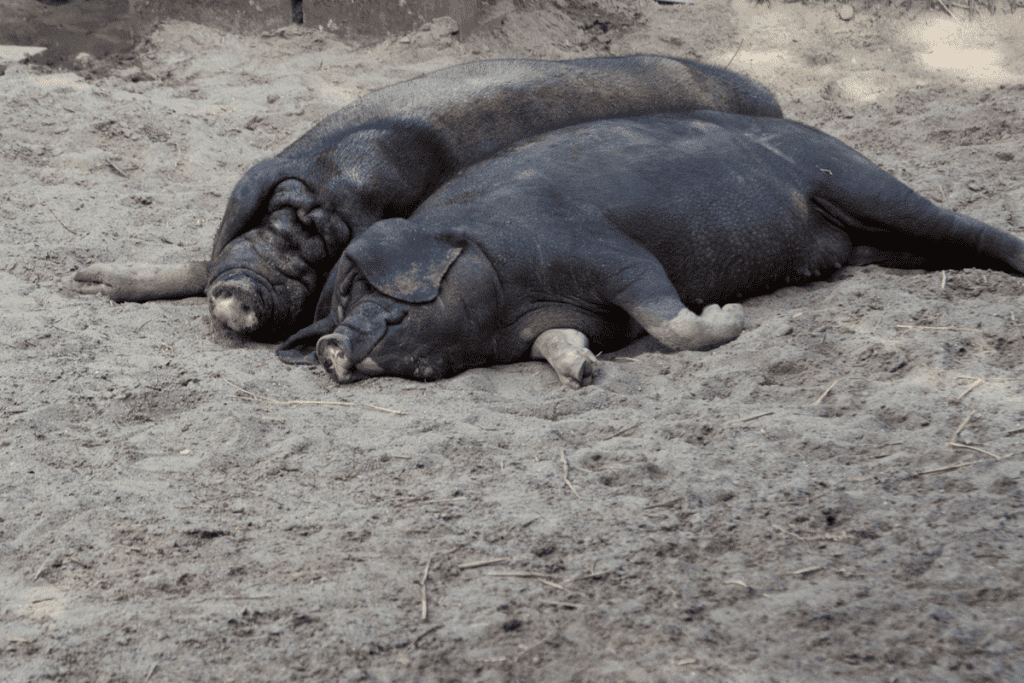
The Meishan pig breed originates in China, and it is one of the oldest domestic pig breeds in the world.
Meishan pigs used to be highly valued for their meat throughout China and Japan, but commercial pig breeds have largely replaced them.
In the United States, the Meishan breed is mainly used for research and breeding purposes due to its endangered status.
Meishan pigs are less active than other breeds, and they have a quiet, docile temperament which makes them easy to care for.
A mature Meishan pig is 25 to 32″ inches tall and weighs between 250 to 400 pounds when fully grown.
The most notable features of the Meishan pig are its large floppy ears and wrinkled face.
Meishan pigs are usually black or brown, with occasional white markings at the tip of the tail, and they have a sparse coat of hair on their body.
The nose of a Meishan is usually short and slightly upturned.
Juliana
The Juliana pig is not formally recognized as an actual breed, but rather it was developed by selectively breeding several species of small pigs to achieve its miniature size.
Because the Juliana is a mix of so many different breeds, it always has spots and is often known as a “miniature painted pig.”
Since Juliana pigs stay so small, they offer minimal meat production, and they are primarily raised as pets or companion animals.
Juliana pigs have a very docile temperament, and they are known for being smart, easy to train, and friendly.
The Juliana pig has an average height between 15-17″ inches and weighs anywhere from 20 to 60 pounds when fully mature.
Although Juliana pigs are specifically bred to be small, there is no guarantee they will be, so do not be surprised if yours grows up to 150 pounds.
Any pig weighing more than 65 pounds is not considered an actual Juliana pig.
Juliana pigs have a coarse furry coat and a base color of silver, white, cream, rust, red or black.
Their spots are usually black, but they may also be white or red, depending on their base color.
Juliana pigs have small erect ears, broad shoulders, and a long, straight snout.
Yucatan
The Yucatan is a hairless small domestic pig breed originating from Mexico, and it has lived in the Yucatan Peninsula for more than five centuries.
Yucatan pigs are very hardy animals, and they are tolerant of tropical climates and resistant to diseases.
They are primarily raised for their meat in their native regions, making excellent pets.
Check out our guide to caring for pet pigs at the link.
Yucatan pigs have a friendly, docile temperament, and their intelligence makes them easy to train.
Yucatan sows are around 18-26″ inches tall, and boars are generally larger at 20-30″ inches in height.
The average weight of this breed is between 150-180 pounds, with boars weighing more than sows due to their taller height.
The Yucatan pig is usually hairless and dark black or gray.
Their ears are large and pointy, and they have a long, straight snout.
Pot-bellied Pig
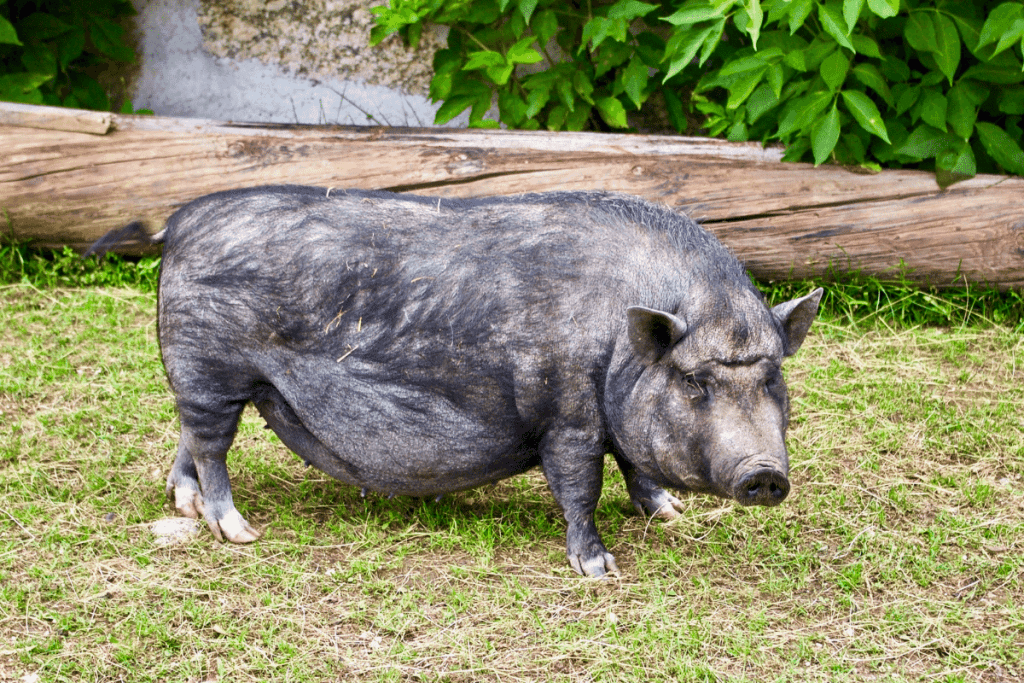
The pot-bellied pigs we are familiar with today originated in Vietnam hundreds of years ago, but they were not brought into the United States until the 1980s.
While the pot-bellied pig is typically classified as a livestock breed, they are very popularly raised as pets.
Pot-bellied pigs have a friendly disposition, and they are known to be smart, curious, and even affectionate toward their owners.
It is best to provide your pot-bellied pig with plenty of stimulation and entertainment, as they tend to root and chew when they are bored, which may be very destructive.
Pot-bellied pigs are 14-20″ inches tall at the shoulders and typically weigh between 70-150 pounds, although it is not unusual for them to reach 200 pounds.
The color of a pot-bellied pig is usually black, but it may also be gray, white, red, or tan, and the skin is wrinkly.
Spots are also common on pot-bellied pigs, and they do not have much hair on their body.
The most notable trait of a pot-bellied pig is its large, sagging belly.
The snout of a pot-bellied big is short and wrinkled, it has a straight tail, and the ears are short and erect.
Gottingen Mini
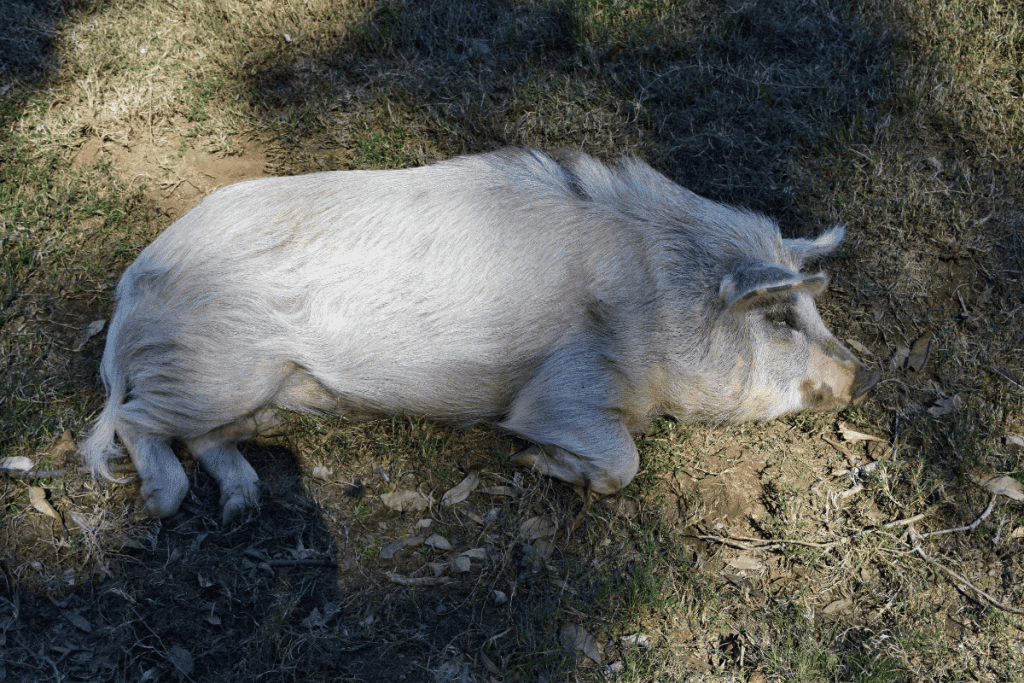
The Gottingen Mini was developed by cross-breeding the German Landrace, Vietnamese Potbellied, and Minnesota Mini pigs.
While the Gottingen was initially bred for medical research, the breed became available in pet stores in 2010.
Gottingen pigs are very friendly, patient, and active, and they are great pets for first-time pig owners.
The Gottingen Mini stays very small, reaching a height of 10 to 20″ inches with an average weight of 60 to 80 pounds.
They usually have white hair and pink skin, but they may also have black spots.
Gottingen pigs have small- to medium-sized ears pointed upward and a medium snout.
Commonly Asked Questions
What type of housing do mini pigs require?
A miniature pig will do well inside your home as long as it is provided with ample space and proper bedding, and it is even possible to litter train them.
Related: What is the best bedding for pigs?
Miniature pigs also need a large outdoor area to exercise every day.
The outdoor space needs to be fenced in for the pig’s safety, and it is essential to avoid treating the grass with any pesticide or herbicide.
Piglets require warm temperatures than adults, so you may need to provide them with a heat lamp in colder weather.
Since pigs cannot sweat, it is essential to provide them with a shady area outside so they can cool down when necessary.
Are pigs compatible with other pets?
Pigs get along exceptionally well with other household pets such as cats and dogs.
However, dogs have been known to attack a pig, even if they have lived together for a while.
To prevent any injuries, it is advisable to supervise any interaction between your pig and dog.
How much does a mini pig cost?
Miniature pigs are expensive due to the selective breeding process to make them small.
The initial purchase price of a miniature pig is $750-$1,100, but they may cost as much as $6,500, depending on the breed.
As a general rule, the smallest breeds, such as the Juliana and Gottingen Mini, are more expensive because of their rarity.
Should you get a pet pig spayed or neutered?
Most pig breeds become sexually mature at 3-4 months of age.
Having your pet pig spayed or neutered is crucial to avoid aggressive or unwanted behavior.
Females are usually spayed when they are 6 to 8 weeks old, and males are neutered between 5 to 8 weeks.
Unaltered pet pigs do not make good pets as they will become aggressive toward humans and other pets, and they will exhibit other undesirable behavior such as marking their territory.
Intact boars will also have faster tusk growth and emit a strong odor.
Spaying or neutering your pet pig also prevents uterine or testicular tumors from forming.
How do I know I am getting the “smaller” version of a pig?
When you purchase a miniature pig, there is no guarantee that the animal will stay small when fully grown.
To get a better idea of how large your pig will be when fully mature, research miniature pig breeds and ask to see the parent pigs whenever possible.
Miniature pigs also exhibit different physical characteristics than normal-sized pigs.
A miniature pig will have shorter legs and a shorter torso when compared to a regular pig.
How useful was this post?
Click on a star to rate it!
We are sorry that this post was not useful for you!
Let us improve this post!
Tell us how we can improve this post?
